Okadera Temple
The Buddha of
Wish-Granting
The temple was founded in 663. The original name of the temple was Ryugaiji, but since ancient times it has been affectionately called “Oka-dera,” meaning "temple on the hill in Asuka village". The main deity, Nyoirin Kannon, is the largest statue made of clay in Japan and was built in the Nara period. The temple is the 7th temple of the 33 Saikoku Kannon Pilgrimage in the western part of Japan. It is also the first sacred place in Japan for expelling of bad luck, therefore, is visited by many people from all over Japan to pray for the fulfillment of their wishes.
HIGHLIGHTS
-
Important Cultural Property
Seated Statue of
Nyoirin Kannon Bosatsu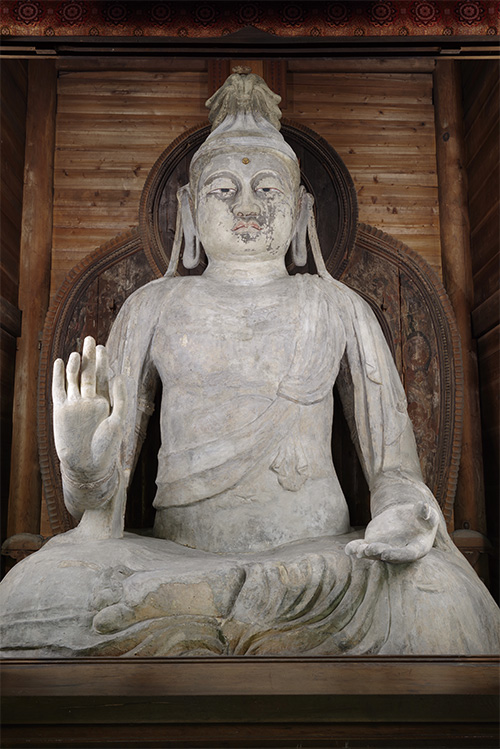
Seated Statue of
Nyoirin Kannon Bosatsu
Important Cultural PropertySeated Statue of
Nyoirin Kannon Bosatsu /
Important Cultural Property
(Nara Period)This Seated Statue of Nyoirin Kannon Bosatsu is the largest Buddhist statue made of clay in Japan.
It is also known as one of the Three Great Buddha Statues.
Although the color has peeled off and the statue is now white, the hair part of the head still retains the color applied when it was built in the 8th century, which let us imagine the gorgeous decorations of that time.
It is said that Kobo Daishi created this statue with soil from the three countries where Buddhism was introduced: Japan, China, and India.The Three Great Buddha Statues in Japan:
[Bronze] The Birushana Buddha of Todaiji Temple (Great Buddha of Nara)
[Wood] The Eleven-Headed Kannon Bosatsu of Hasedera Temple
[Clay] The Nyoirin Kannon Bosatsu of Okadera Temple -
Hon-do Hall (Main Hall)
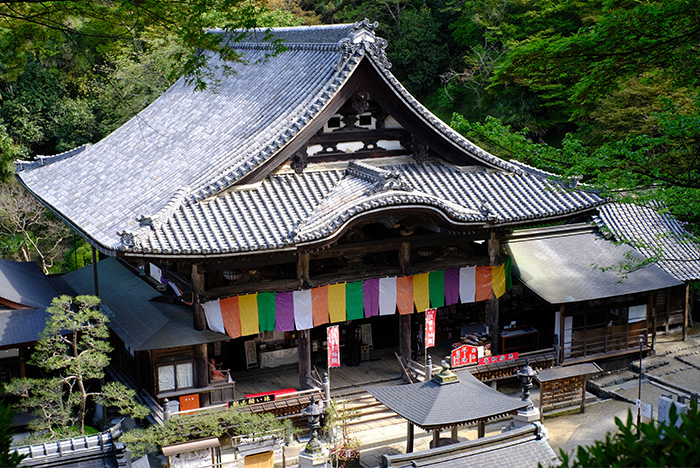
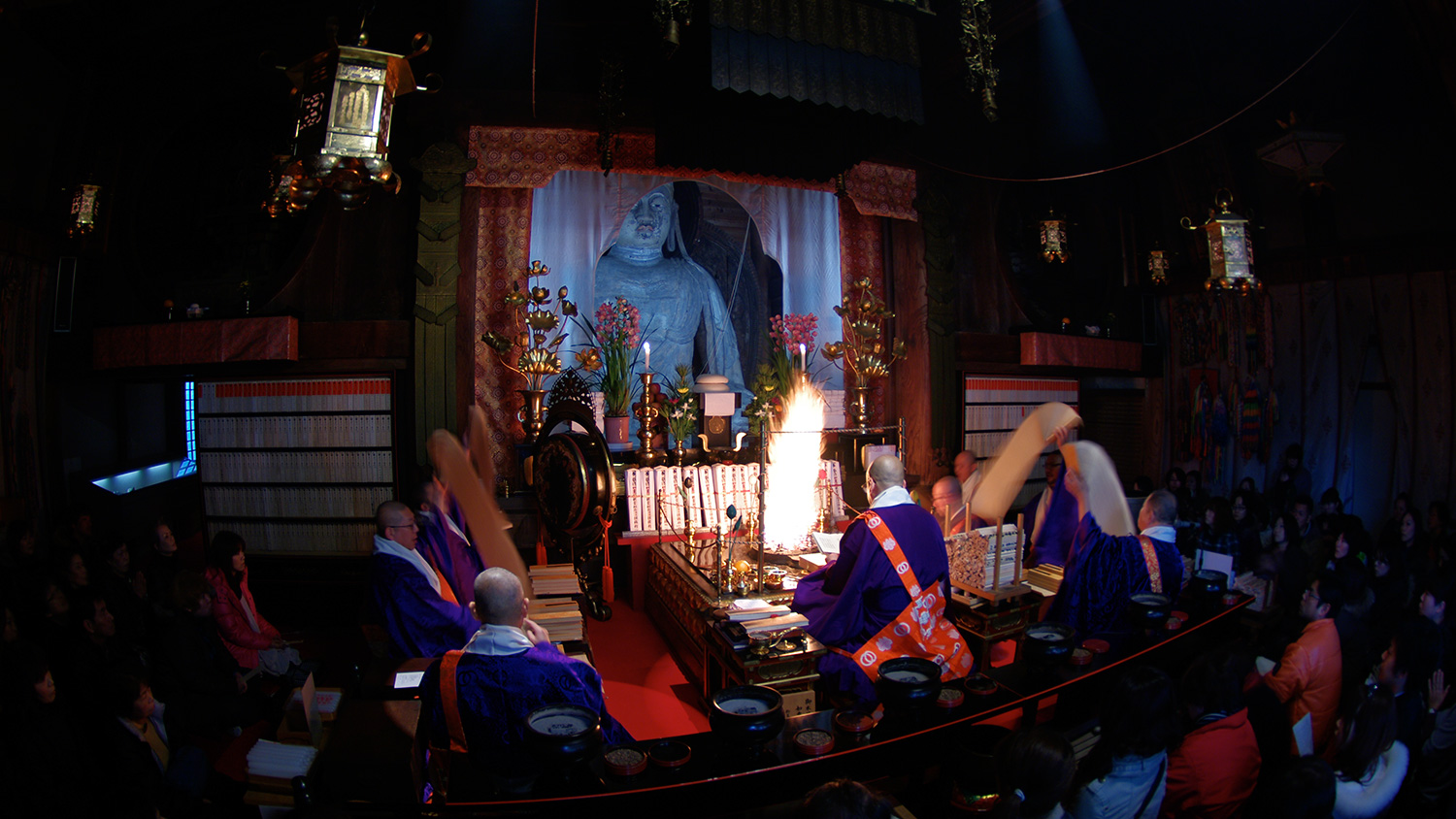
Hon-do Hall (Main Hall)
Hon-do Hall (Main Hall) / Built in the early 19th century
The largest building of Okadera Temple is the Hon-do Hall.
It houses the main image of the temple which is about 4.6 meters high.
Important ceremonies are held in this building such as Hatsu Uma Goma Fire Ritual. -
Important Cultural Property
Nio-mon Gate
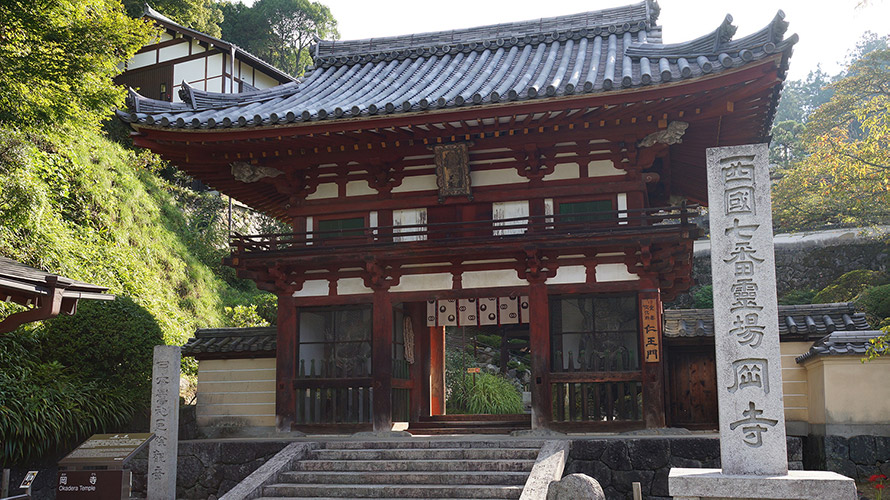
Nio-mon Gate
Important Cultural PropertyNio-mon Gate / Important Cultural Property / Built in 1612
The gate has quite a lot of rare ornaments including a pair of lions, a dragon and tiger placed under the roof.
-
Seasonal Flowers
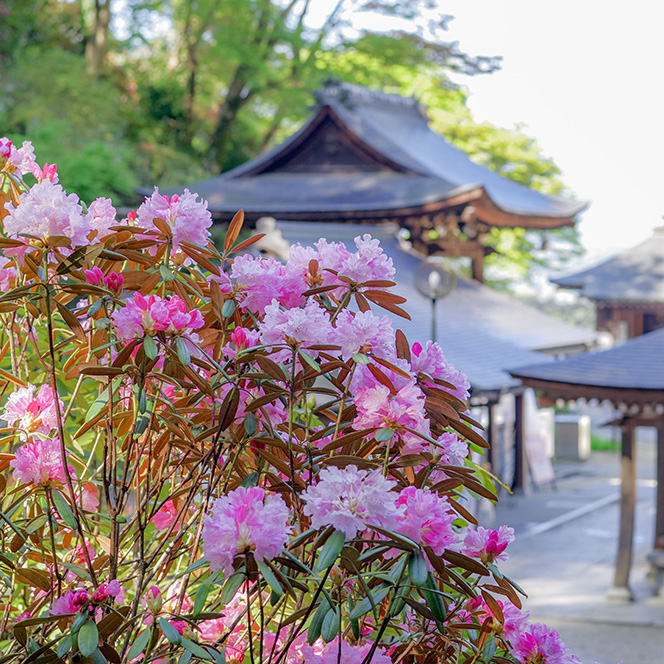
April: Rhododendron 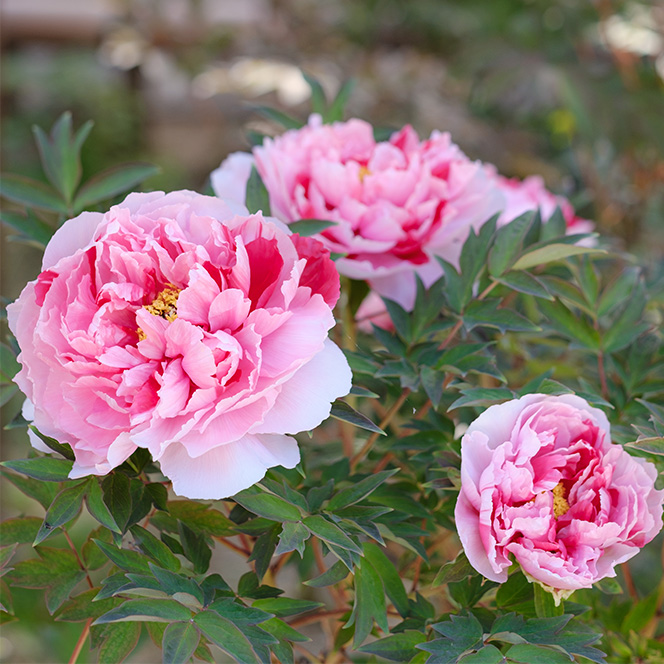
April: Peony 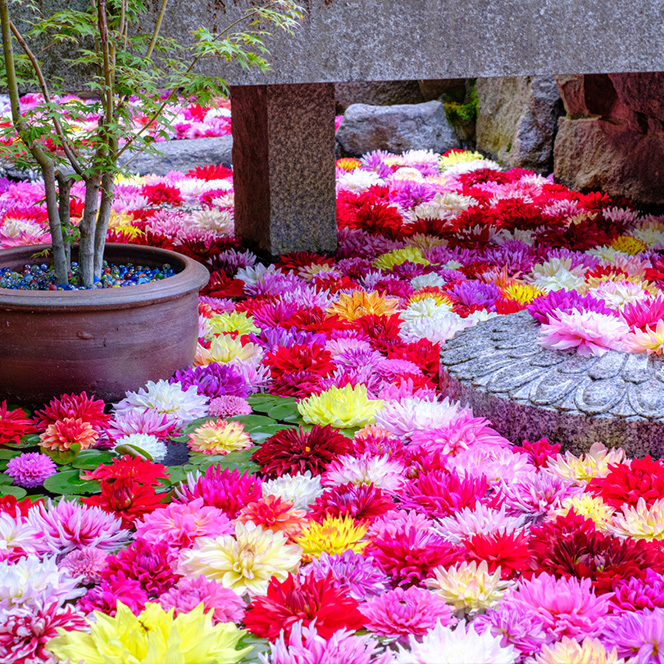
End of April to early May: Flowers on the pond 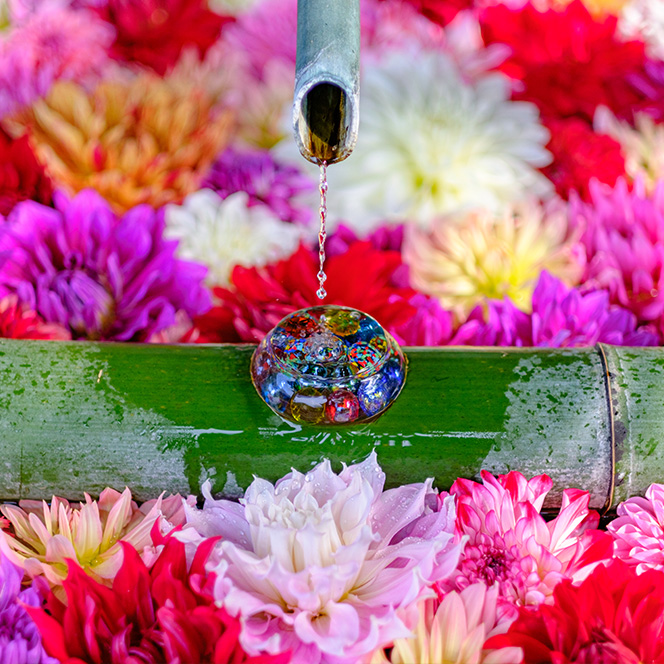
End of April to early May: Flowers on the pond 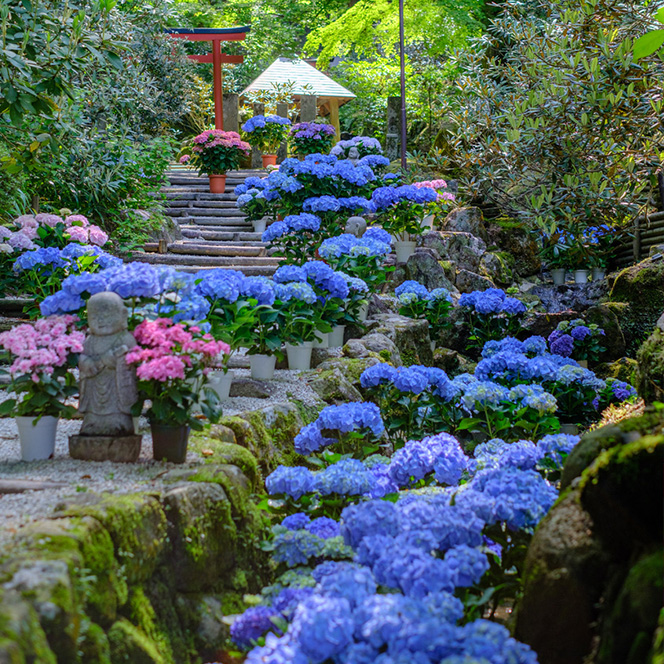
June: Hydrangea 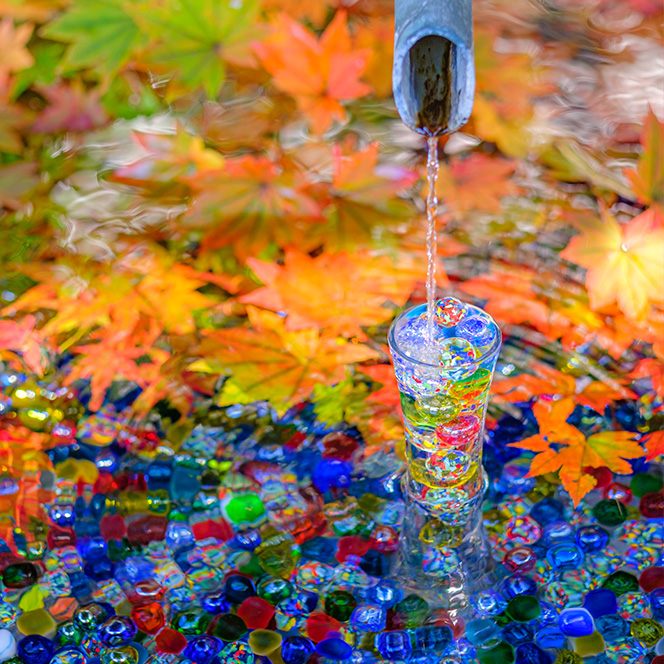
November: Maple -
Three-storied Pagoda
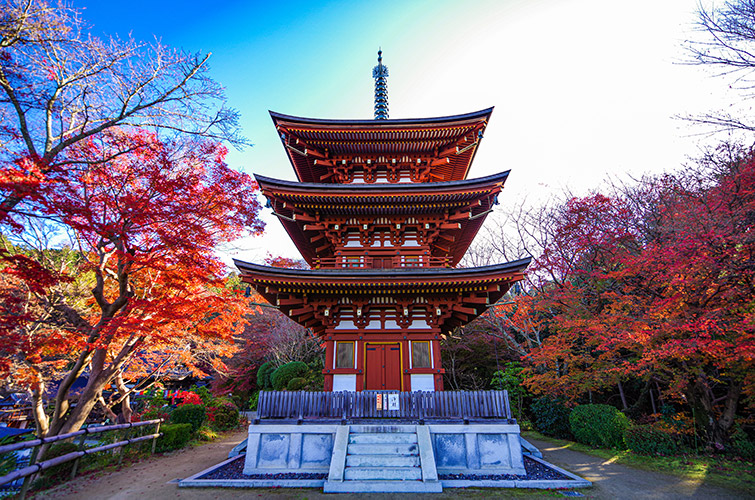
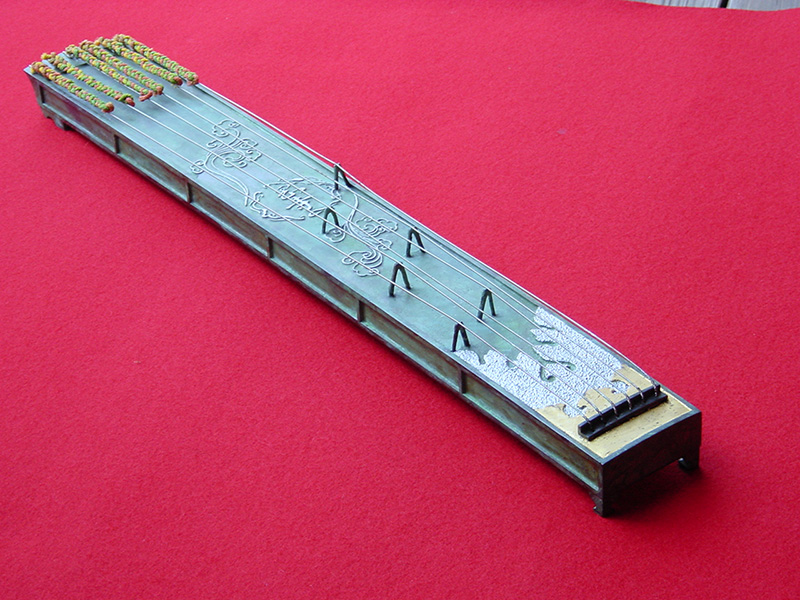
Three-storied Pagoda
The original three-storied pagoda collapsed due to a strong typhoon in 1472.
The construction of the new three-storied pagoda was started in 1984 at the commemorating year of the 1150th anniversary of Kobo Daishi's death.
The construction completed in 1986, and the pagoda finally erected in the temple after 514 years.
There is a Koto (Japanese harp) hung on the eaves of the pagoda as an ornament which is rarely seen. -
Shoro-do Hall,
or the Bell Tower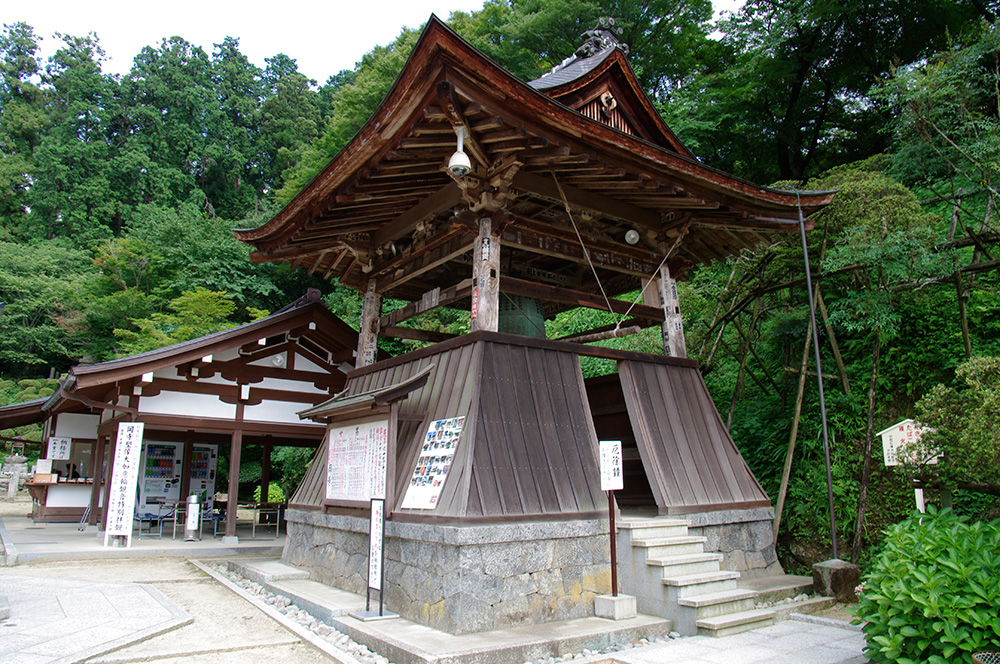
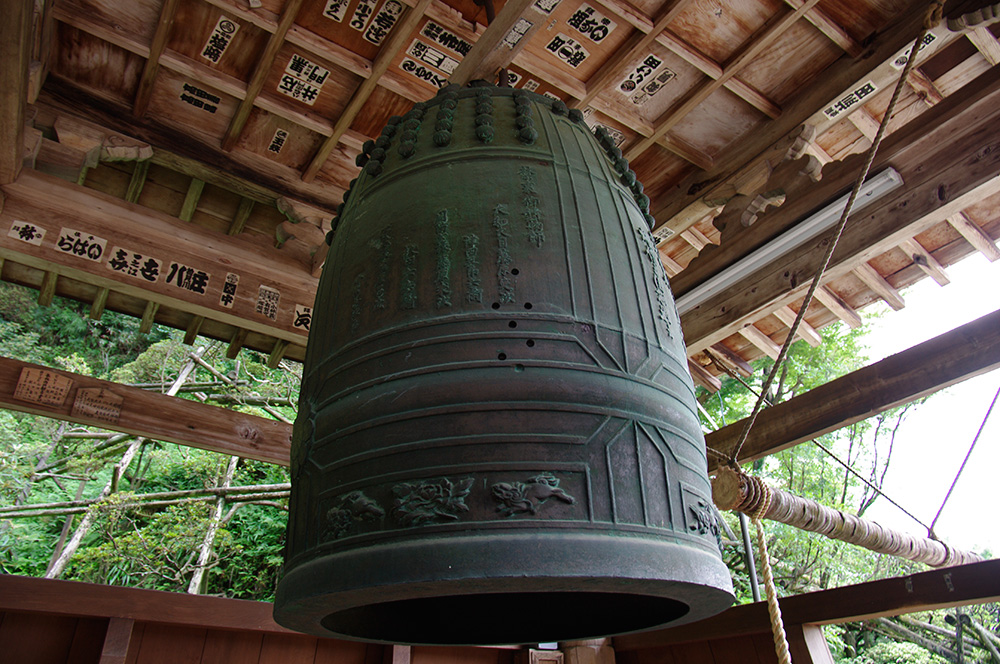
Shoro-do Hall,
or the Bell TowerConstructed in the early 19th century.
The temple bell of Okadera Temple has seven holes which were drilled to test the material in order to see if the bell could be used for the war.
Thanks to the hard work of those who tried to protect the bell and the mysterious power of Kannon, the bell wasn’t used in the war.
The bells are treasured as a symbol to ward off evil and to pray for peace.
The bell has a very pleasant tone, so ring it for good luck when you visit the temple. -
Okuno-in Hall,
or the Inner Sanctuary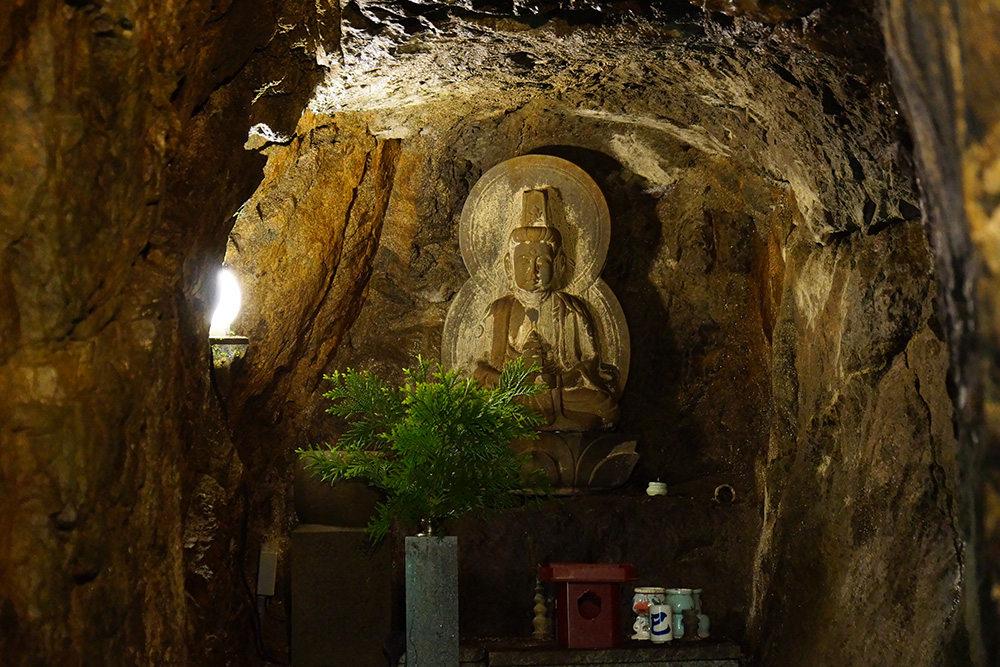
Okuno-in Hall,
or the Inner SanctuaryThe path from the main hall to the inner sanctuary, which rises gently up the hill on the mountain side, allows visitors to stroll through the green grove of trees while admiring the seasonal flowers.
Along the way, you will see a mausoleum of the founder of the temple, Monk Gien, a natural spring associated with Kobo Daishi, a stone Buddha's foot and a stone Buddha, all of which suggest that this is a place of prayer.
There is a stone cave called "Miroku Cave" where a seated statue of Miroku Bosatsu is enshrined in the back.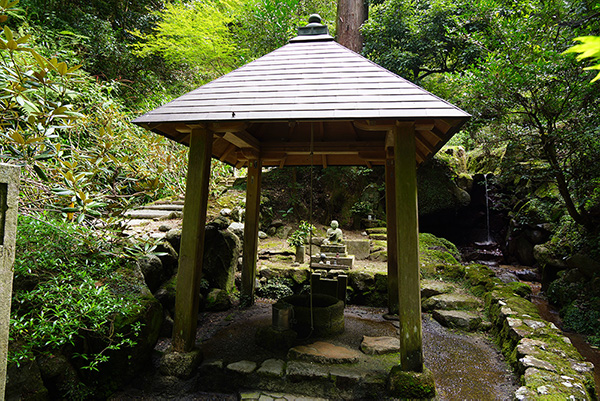
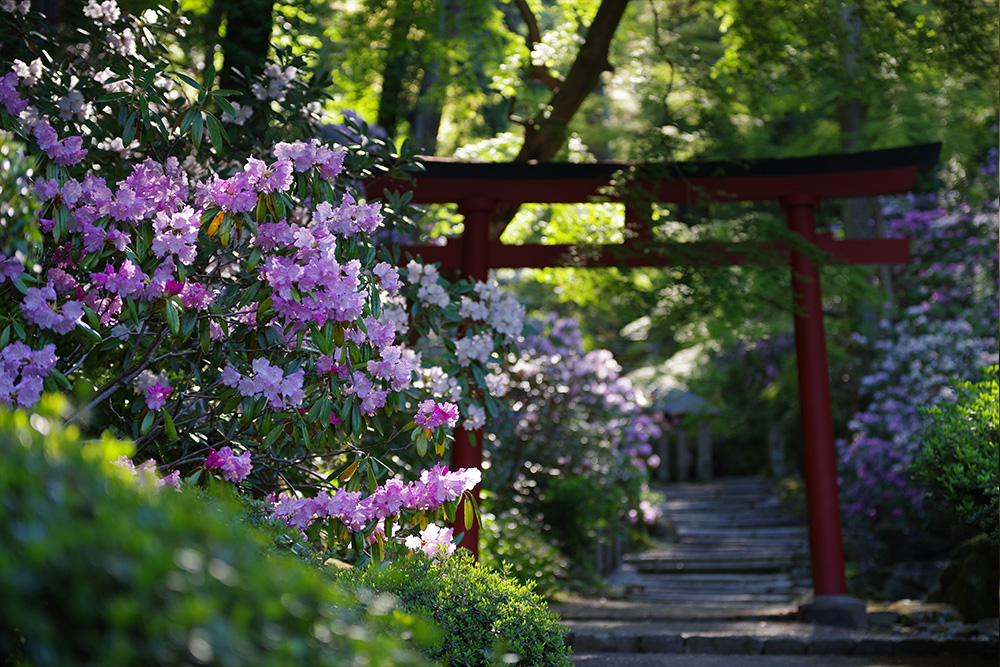
-
Breathtakingly Beautiful Autumn Colors
Okadera temple brightened with the colors of the autumn leaves which seem to completely surround its precincts.
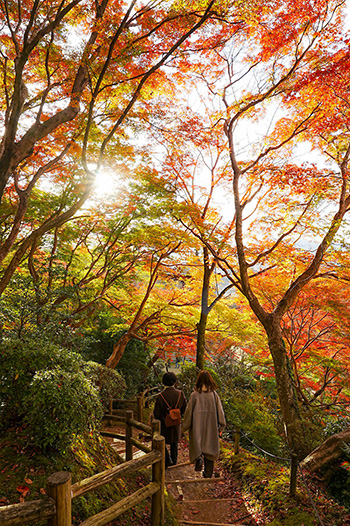
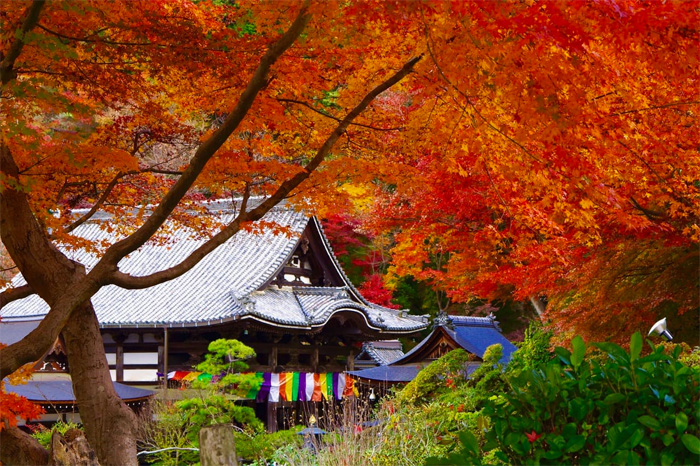
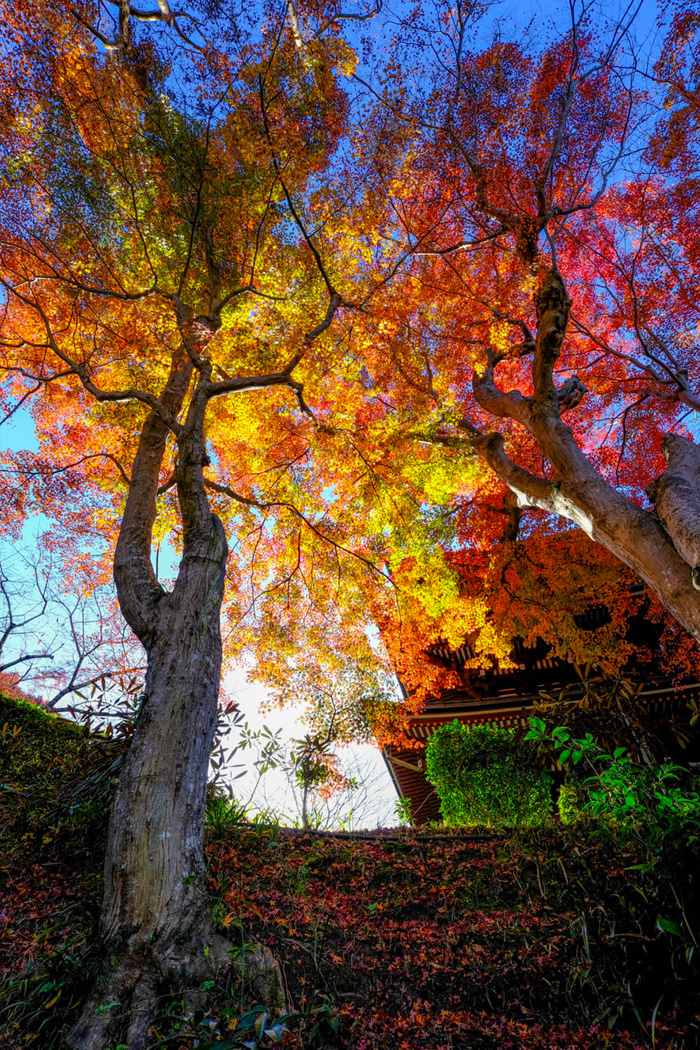
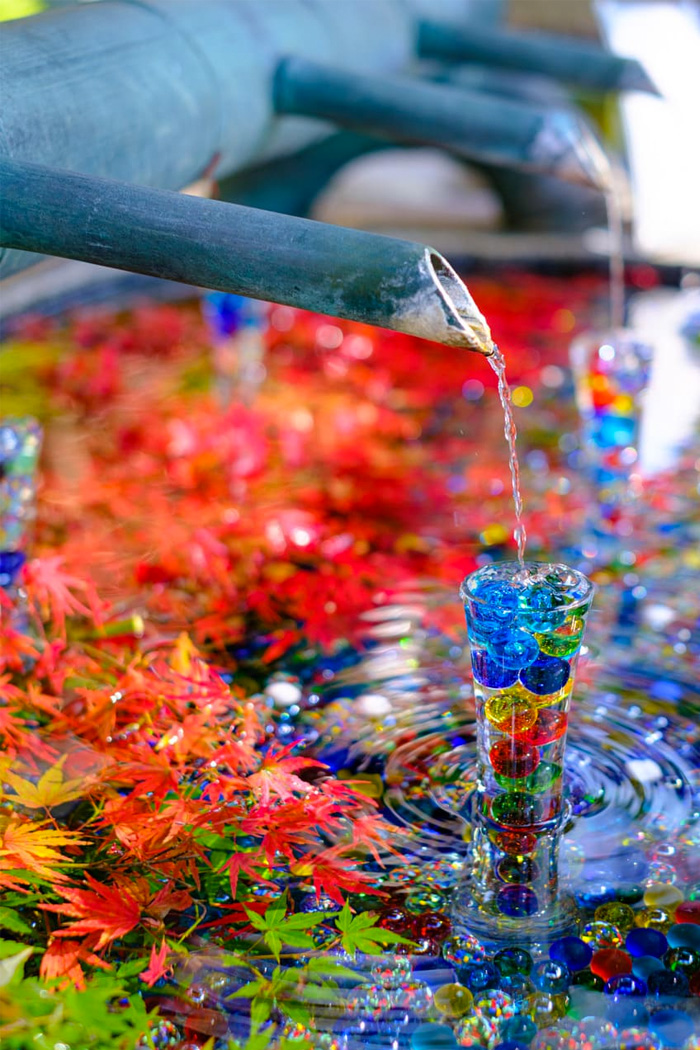
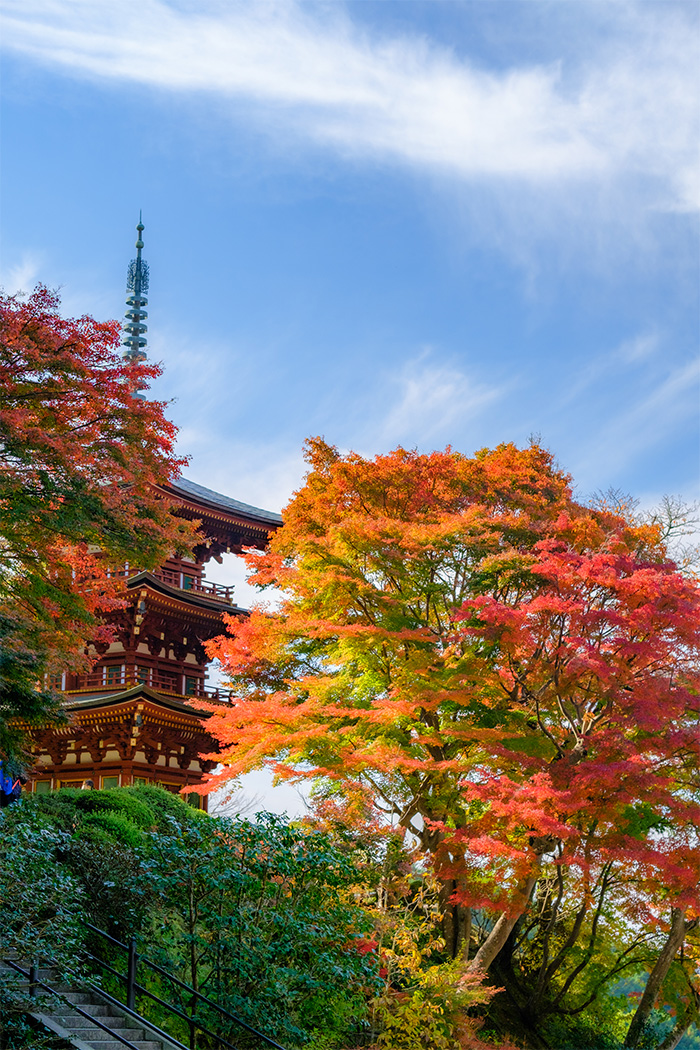
-
The Legend of the
“Dragon Lid” Pond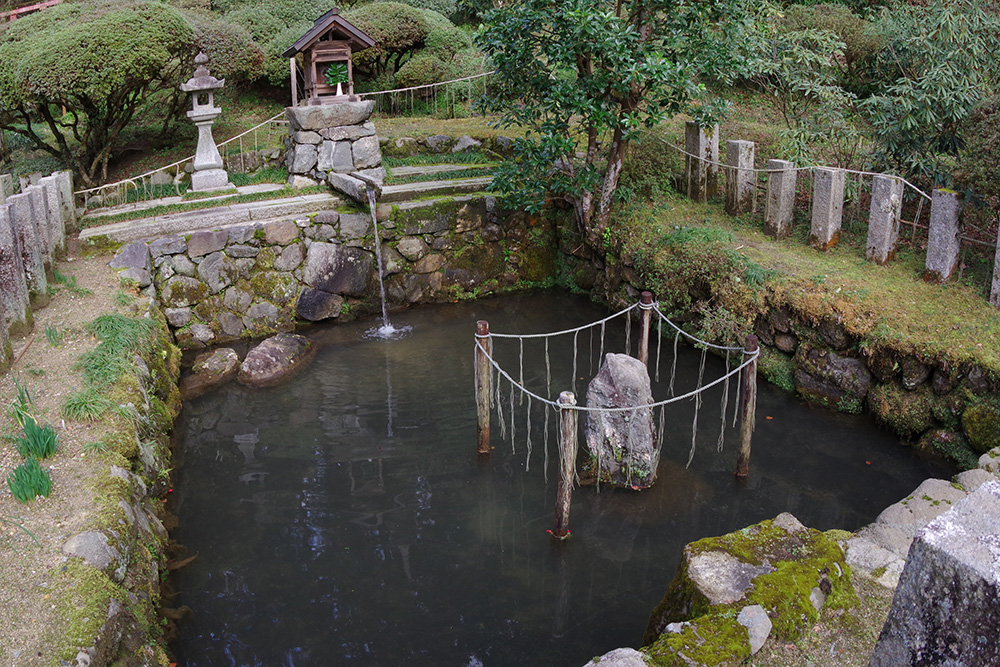
The Legend of the
“Dragon Lid” PondA Legend says that the monk Gien used his magical power to contain an evil dragon that was ravaging the Asuka area and tormenting the people, and then covered the pond with a large stone to reform the dragon.
This is how the temple got it original name, "Ryugaiji” or "dragon lid temple."
The pond is still in the temple grounds today and called Ryugai (dragon lid) Pond.
It is said that if one touches the large keystone that serves as the lid, then, rain will fall.
The removal of this evil dragon's misfortune started the belief in the protection of the temple from evil that has continued to the present day.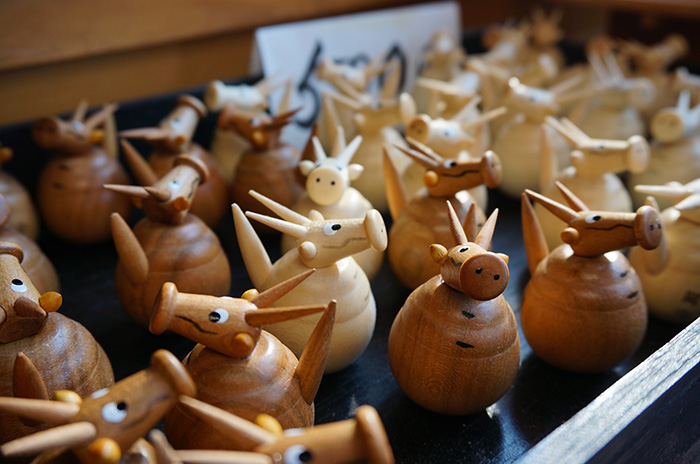
About Dragon Belief
Ryujin, or dragon gods, are divine or spiritual beasts.
In Japan, they are believed to be the gods that govern mainly weather and water-related events.
As the name suggests, Ryugaiji Temple is deeply associated with dragons.
It is said that the dragon holds a gem ball called Nyoihoju, a wish-fulfilling gem.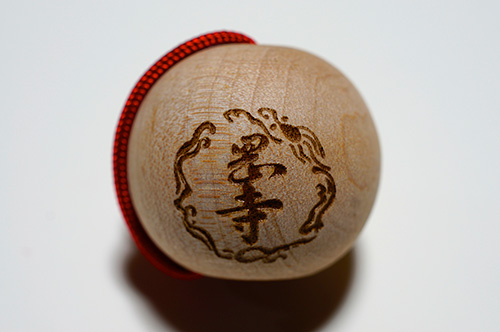
Dragon Talismans 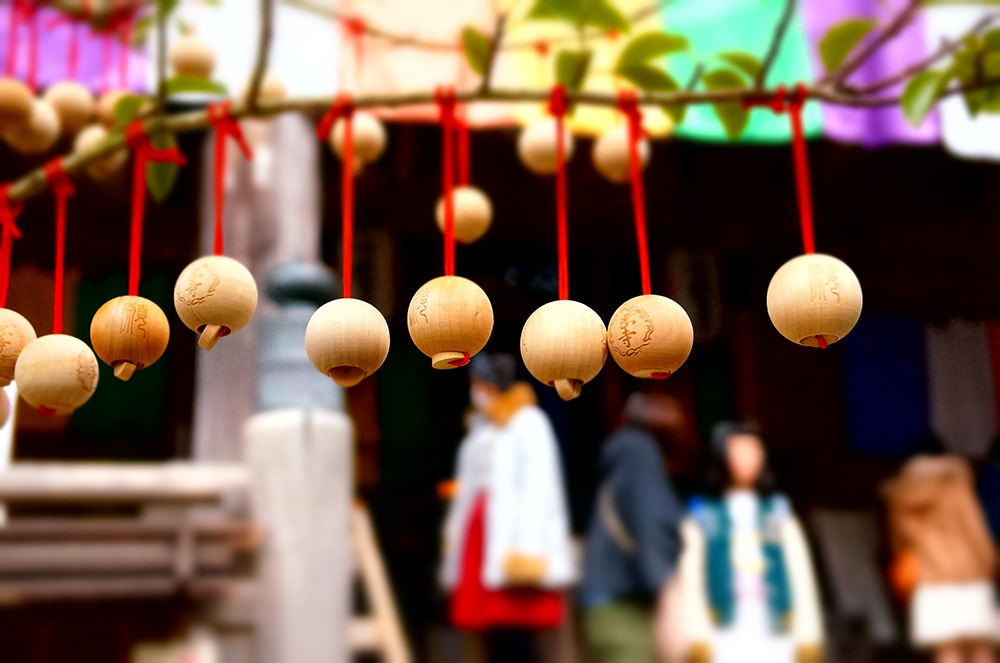
Dragon Wish-Granting Balls
Cultural Assets
-
Seated Statue of Gien Sojo
- Category
- National Treasure (sculpture)
- Era
- Around the end of the 8th century
- Outline
- This statue was made with the Mokushin Kanshitsu technique (the technique is used to complete the statue by making a rough wooden sculpture and then applying lacquer and lacquer-mixed wood powder to the surface). Colored, 93.0 cm high. Gien Sojo, a Buddhist monk, was the founder of Okadera Temple who was the leader of Buddhism in the early 8th century. This statue is a portrait sculpture of him that has been handed down in the temple. It is currently housed at the Nara National Museum.
-
Molding Seated Nyoirin Kannon(Bodhisattva Kannon <Avalokiteshvara>)
- Category
- Important Cultural Property (sculpture))
- Era
- Nara period
- Outline
- Molded statue. Colored, 458.2 cm high. It is the largest molded statue in Japan, and is notable as an example of the fact that huge molded statues were produced in the Nara period (710-794). It is also considered important as the oldest example of the Nyorin Kannon, and shows the richness of Buddhist culture in the Nara period, both as a statue and as an object of faith.
-
Nyoirin Kanzeon Bosatsu (Bodhisattva Kannon <Avalokiteshvara>) Seating Contemplatively in the Half Lotus Position
- Category
- Important Cultural Property (sculpture)
- Era
- Nara period
- Outline
- This statue is made of gold and copper using a mold and is 31.2 cm high. It is said to have been housed inside of the seated statue of the Dai Nyorin Kannon. Currently the statue is housed at the Kyoto National Museum. A reproduction of the statue is enshrined at Okadera Temple.
-
Shakyamuni Buddha Entering Nirvana
- Category
- Important Cultural Property (sculpture)
- Era
- End of Heian period to Kamakura period
- Outline
- This life-size wooden statue of 171.1 cm long is a very rare example of statuary. The figure lies having the head rested on the right arm and the left arm resting straightly on the side of the body. It is considered extremely valuable as it is one of the few wood carvings of the image of the lying Shakyamuni Buddha. The statue is currently on deposit at the Tokyo National Museum.
-
Earthen Plate with the Celestial Figure
- Category
- Important Cultural Property (sculpture)
- Era
- Hakuho period
- Outline
- This earthen plate called “Sen” is 39 cm long and 39 cm wide and 8 cm thick. It is said that this square plate with patterns was excavated from the site of Okadera Temple. A Sen is a brick or tile-like ware formed by packing clay into a mold. The four circumferences are surrounded by a 3cm-wide pattern and there is the relief of the image of a celestial being on the center. Few of similar examples of this type of plate have not been excavated in Japan, therefore, it is considered to be extremely valuable.
-
Okadera Temple Niomon Gate
- Category
- Important Cultural Property (building structure)
- Era
- Early Edo period (1612)
- Outline
- The present Niomon Gate has three pillars on the front and one of the space on the middle between two pillars was a doorway. It is the Irimoya-zukuri style architecture with Hon Kawara-buki tiled roof (hip-and-gable style roof). The gate was erected in 1612 using old materials. The foundation stones are from the Nara period (710-794).
-
Okadera Temple Shoin
- Category
- Important Cultural Property (building structure)
- Era
- End of Azuchi Momoyama period to early Edo period
- Outline
- The Shoin building stands to the northwest of the main hall whose width is about 13 meters and the beam length of about 10 meters. The roof has the Kiritsuma style with the Kokera-buki (a method of construction in which layers of wood shingles are layered on top of each other). It is partly made of copper with eaves on both the east and west sides.
GUIDE / ACCESS
| Opening Hours: | 8:30 a.m.-5:00 p.m. (March-November:) 8:30 a.m.-4:30 p.m. (December-February) |
|---|---|
| Admission: |
Adults ¥400, High School Students ¥300, Junior High School Students ¥200 free of charge for Elementary School Students or younger |
| Address: | 806 Oka, Asuka-mura, Takaichi-gun, Nara |
| Access: | From Kintetsu Kashihara-jingumae Station, take a bus to the "Okadera-mae" bus stop. |